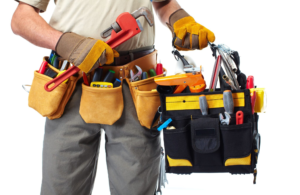Cabinet Painting Sacramento is a big project that requires good surface preparation for the best quality paint job. This includes removing all doors, drawers and boxes. It also involves sanding the surfaces and cleaning.

Cleaners degrease the cabinets and help to remove grease and natural skin oils that can cause problems with paint adhesion in moisture prone areas like kitchens. Lightly scuff sanding is a great way to improve paint adhesion as well.
If you are going to paint your cabinets, it’s important to understand that it isn’t as simple as just brushing on a coat of your desired color. The process requires prep work, including cleaning, sanding, priming, painting, and curing. It’s not something that most homeowners can successfully take on themselves, and it may be a job better left for the professionals.
The most critical step in cabinet painting is making sure the surfaces are clean. Using a degreaser will remove any oil, grease, and gunk that has built up over time. This will ensure that your new paint adheres to the surface, and will help prevent future chips.
It’s also a good idea to sand the cabinet surfaces down, which will prepare them for the primer and provide a smooth surface for your final coat of paint. This will also remove any flaws or imperfections that might be visible once the cabinet is painted, such as dings or scratches. You can use a hand sander or a power sander, and it’s usually best to sand in the direction of the grain.
When sanding, you should wear a dust mask to protect yourself. Once the sanding is done, you’ll need to apply a thin coat of a high-quality primer. This will seal the surface and create a base for the final coat of paint. There are many different types of primers, and you should consult with a professional at your local hardware store to determine which one is right for you.
Once the primer has dried, you can begin painting. Most pros recommend starting with the doors and working your way to the boxes. This will ensure that the doors are dry before you reattach them, and it will give the boxes a chance to dry before you paint over them.
It’s also a good idea to label each door and box with numbers so that you know which is which when you reinstall them. Using sticky notes is a great way to do this, and you can also make a list on your phone or computer to keep track of which doors go where.
Priming
When painting cabinets, it is important to prime the surface to prevent the original dark color from bleeding through and altering your new light color. This step will also ensure that your new paint job lasts. The best way to achieve a smooth finish is to apply multiple thin coats and let each dry completely before adding another. Sand lightly between each coat to get a beautiful smooth finish.
If you have oil-based paint on your cabinetry, you may need to strip it before repainting. However, if you have latex paint on your cabinets, you can usually skip this step. You should always use a low-VOC paint for health and environmental reasons.
Prior to priming, you should empty your cabinets and relocate any items that can be moved into a different room for safety. Then, remove the cabinet doors and carefully mark them with sticky notes to match them back up when the project is finished. You will need to remove any hardware such as handles or knobs before starting the job. It is a good idea to remove the hinges and screws as well to prevent them from falling or getting lost during the job.
After removing the doors and hardware, you should clean the cabinet surfaces thoroughly with a degreasing product to ensure that all grease and grime is removed. This is important because a cabinet surface that contains grease will not bond with the primer and paint and can lead to a blotchy or patchy appearance. You can use products like liquid deglosser, denatured alcohol or trisodium phosphate (TSP) to clean your cabinetry.
You should also consider using a spackling compound to fill any holes, cracks or dings in the cabinetry before priming and painting. This will make a much cleaner look and will prevent the wood from showing through your final product.
You can choose from a variety of primers depending on your specific needs. Stain-blocking primers are great for hiding nicotine stains or water damage, while adhesion primers create a strong bond that will not peel. If you are sensitive to odors or need a fast drying product, a shellac-based primer might be your best option. You can even find mildew-resistant primers that are ideal for moisture prone areas like kitchens.
Painting
A professional-looking finish is essential when painting cabinets. It takes time and practice to get the job done right, but doing it correctly will result in a beautiful new look for your kitchen.
To achieve a high-quality finish, it’s important to prepare the cabinet surface for paint. This includes cleaning, sanding, and priming. Primer provides a smooth surface for the paint to adhere to, and it also helps to hide imperfections. It is important to use a primer that is specifically made for cabinet painting, and it is best to choose one with a mildew-resistant coating for moisture-prone areas like the kitchen.
Before starting the cabinet painting process, it’s a good idea to remove the hardware from the doors and drawer fronts, as well as the hinges. This will make the job much easier, and it will help prevent the possibility of getting paint on your knobs or handles. It is also a good idea to label the hinges and hardware in Ziploc bags, so that you know what goes where when it’s time to put everything back together.
Once the cabinet boxes are clean, it’s a good idea to wipe them down with a degreaser or TSP solution. This will help to ensure that all of the grease and dirt is removed, so that the new paint will stick. If you don’t clean the boxes thoroughly, the new paint will flake and chip.
It’s also a good idea to lightly sand the surfaces of the cabinet boxes and cabinet doors. This will help to scuff up the existing surface, and it will give the primer and paint something to adhere to. Once you’re done sanding, wipe off any dust with a damp cloth.
If you’re using an oil-based primer, it’s a good idea to wait for the product to dry before beginning the cabinet painting process. This will help to prevent the oil from dripping onto the fresh paint, and it will also make the new coat of paint last longer. Water-based primers usually work just fine, but they aren’t as durable as oil-based products.
Finishing
If you’re a homeowner and want to make a significant change in your kitchen, painting cabinets is an excellent option. It can be a relatively easy DIY project, but there are some things that you should know before getting started.
A quality paint job is the best way to get your new cabinet colors to look their very best. Cabinets are subject to a lot of wear and tear from heat, food stains, splatters, and abrasions, so it’s important that your chosen finish stands up well. A durable, high-impact hybrid water/oil-based cabinet enamel is what many professionals use for their projects.
Before you start, remove the hardware from your cabinets and clean all surfaces to be painted. You’ll need to clean thoroughly in order to remove grease and oil build-up, as these can prevent paint from adhering. You can use liquid de-glosser, a degreaser, or TSP (trisodium phosphate) to achieve this. It’s a good idea to wipe down the cabinet doors as well, as they tend to collect more grime than the boxes.
After cleaning, lightly sand all surfaces to be painted to scuff the old sheen. If you can, opt for an electric sander as this is much faster and more effective than sanding with a hand-held sander. You should also take this opportunity to fill in any dents and holes, as they will show through the finished paint job.
Next, you should sand again to create an even surface for the primer and subsequent coats of paint. If you can, opt for a finer grit sandpaper such as 220-320 grit to achieve a smoother surface. Once you’re done, remove the sanding dust and wipe down all surfaces to prepare them for priming.
Once everything is ready to prime, you can begin painting the cabinet doors. Be sure to use a foam roller for large flat surfaces and a soft-bristled brush to get into corners and tight spots. If you’re sanding between coats, let the previous coat dry overnight before starting the next one.
Once the first coat is dry, you can reattach the cabinet hardware and enjoy your freshly-painted cabinets. Depending on the color you choose, it may take 2 weeks for the paint to cure, so be sure to plan accordingly.
